This document discusses methods for ontology reuse in linked data publishing, emphasizing the significance of ontology design patterns (ODPs) for improving semantic interoperability. It categorizes different reuse models and their impacts on usability, sustainability, and interoperability, while highlighting best practices for selecting and implementing these models. The document also addresses various challenges and considerations that ontology developers face in reusing ontologies, providing insights into both theoretical frameworks and practical applications.
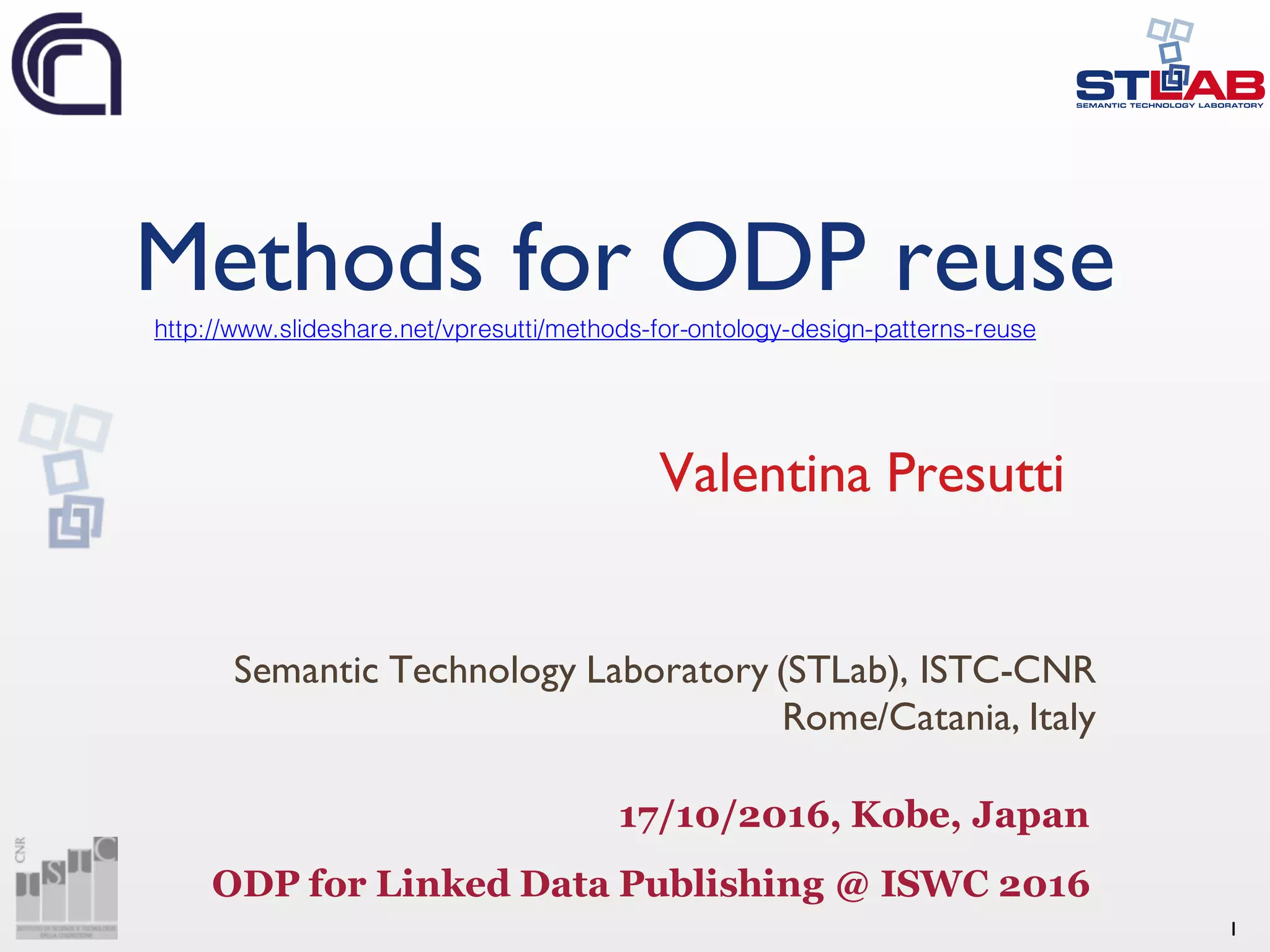
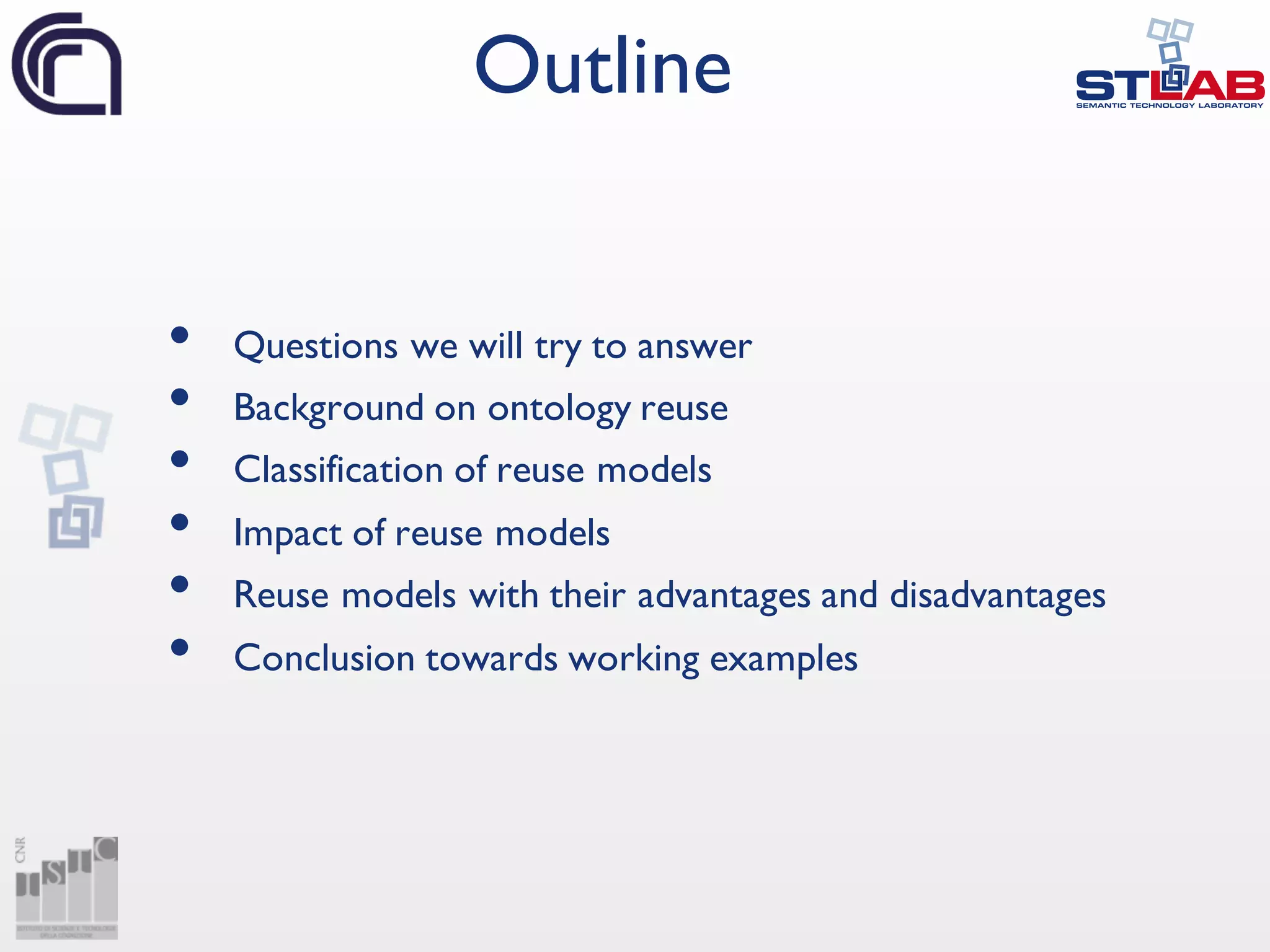
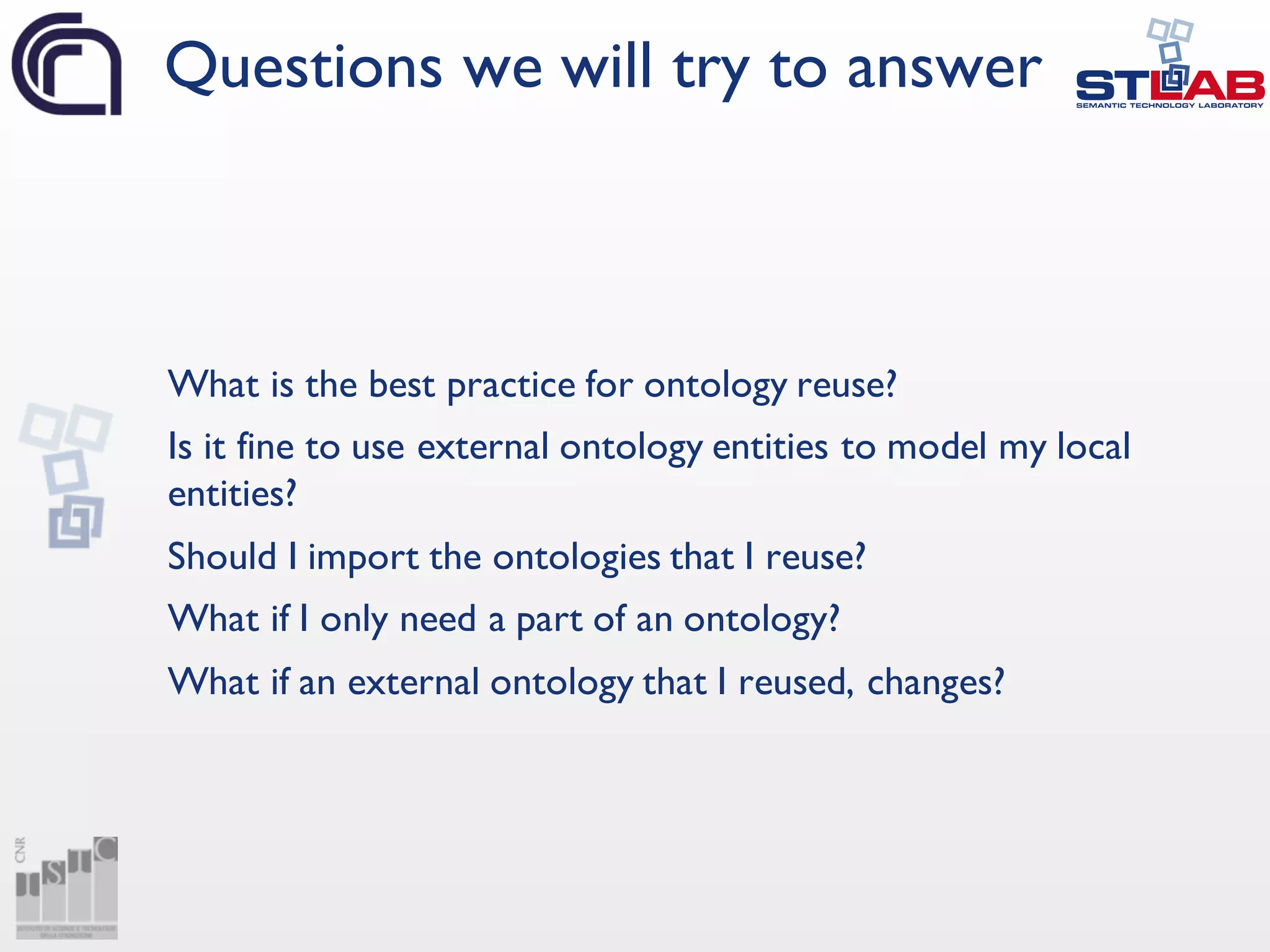
![Ontology reuse is a recommended practice (see e.g. [Burleson et al.,
2014], [Bizer et al., 2009])
reuse of standard vocabularies
linked data principles
It favors semantic interoperability [Simperl, 2009]
knowledge reuse is a key success factor for the Semantic Web
reusability is an intrinsic property of ontologies
Ontology Design Patterns (ODP) [Gangemi, 2005]
they make reuse easier, as they isolate specific requirements
Ontology reuse](https://image.slidesharecdn.com/valentina-161016132631/75/Methods-for-Ontology-Design-Patterns-reuse-4-2048.jpg)
![[d’Aquin and Noy, 2012]: how to choose ontology libraries and current
open issues for ontology library developers (many are still open)
[Suárez-Figueroa et al., 2011]: methodological guidelines for ontology
engineering. As for reuse it identifies two main scenarios and lists the main
activities that characterise them: reuse of ontologies as they are and reuse
by alignment. ODP reuse is also considered but the possible process is not
detailed in terms of activities
[Fernández-López et al, 2011]: guidelines on how to identify parts of
ontologies to be reused
[Schaible et al, 2014]: survey on vocabulary reuse strategies in linked data.
It shows that popularity of vocabulary is one of the most used criteria for
reuse and that the focus is at terminology reuse
This tutorial is mainly based on [Presutti et al, 2016], [Lodi et al, 2016],
and [Hammar and Presutti, 2016] which focus on ontology design patterns
reuse for linked open data publishing
Literature on ontology reuse](https://image.slidesharecdn.com/valentina-161016132631/75/Methods-for-Ontology-Design-Patterns-reuse-5-2048.jpg)
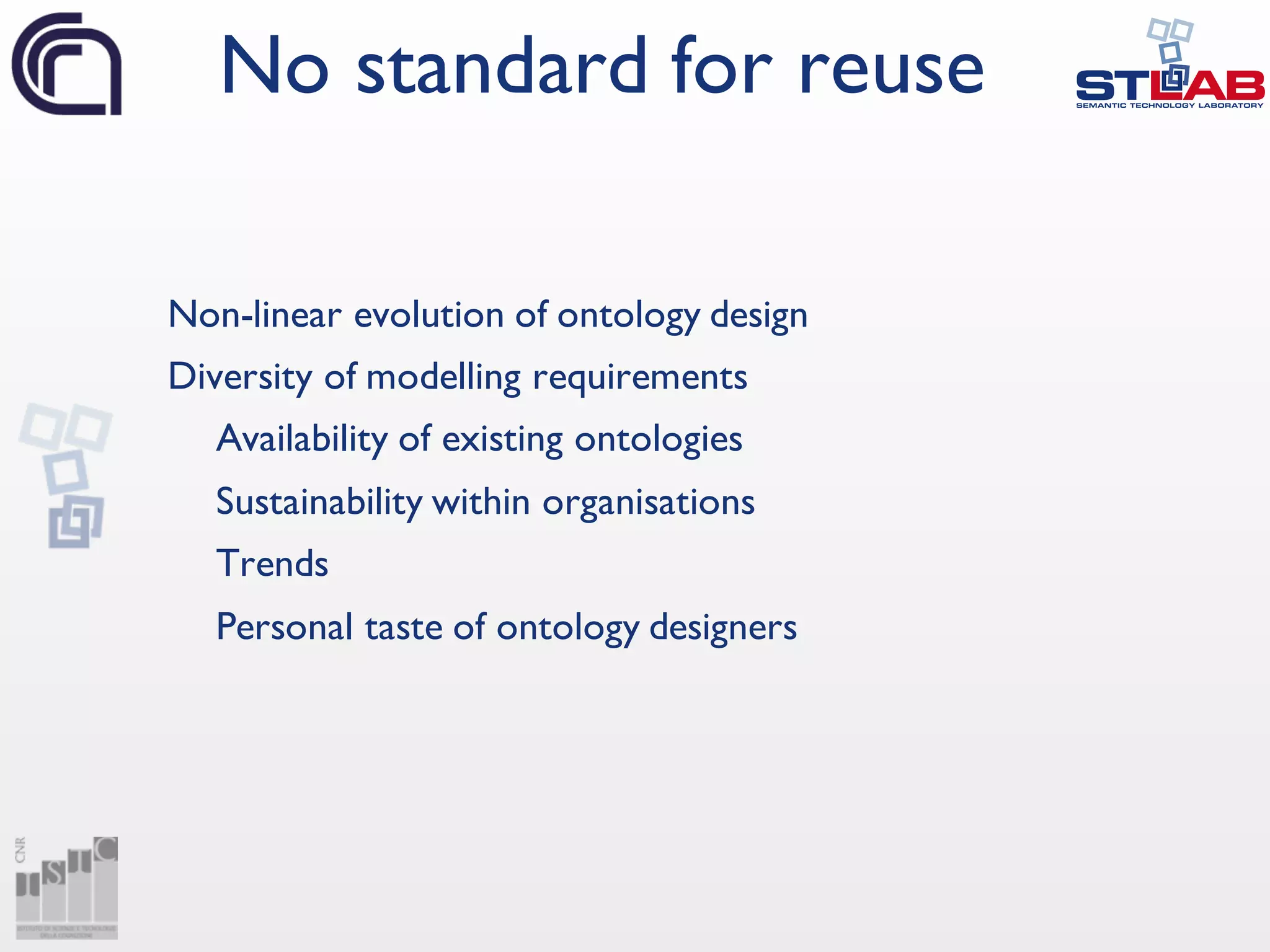
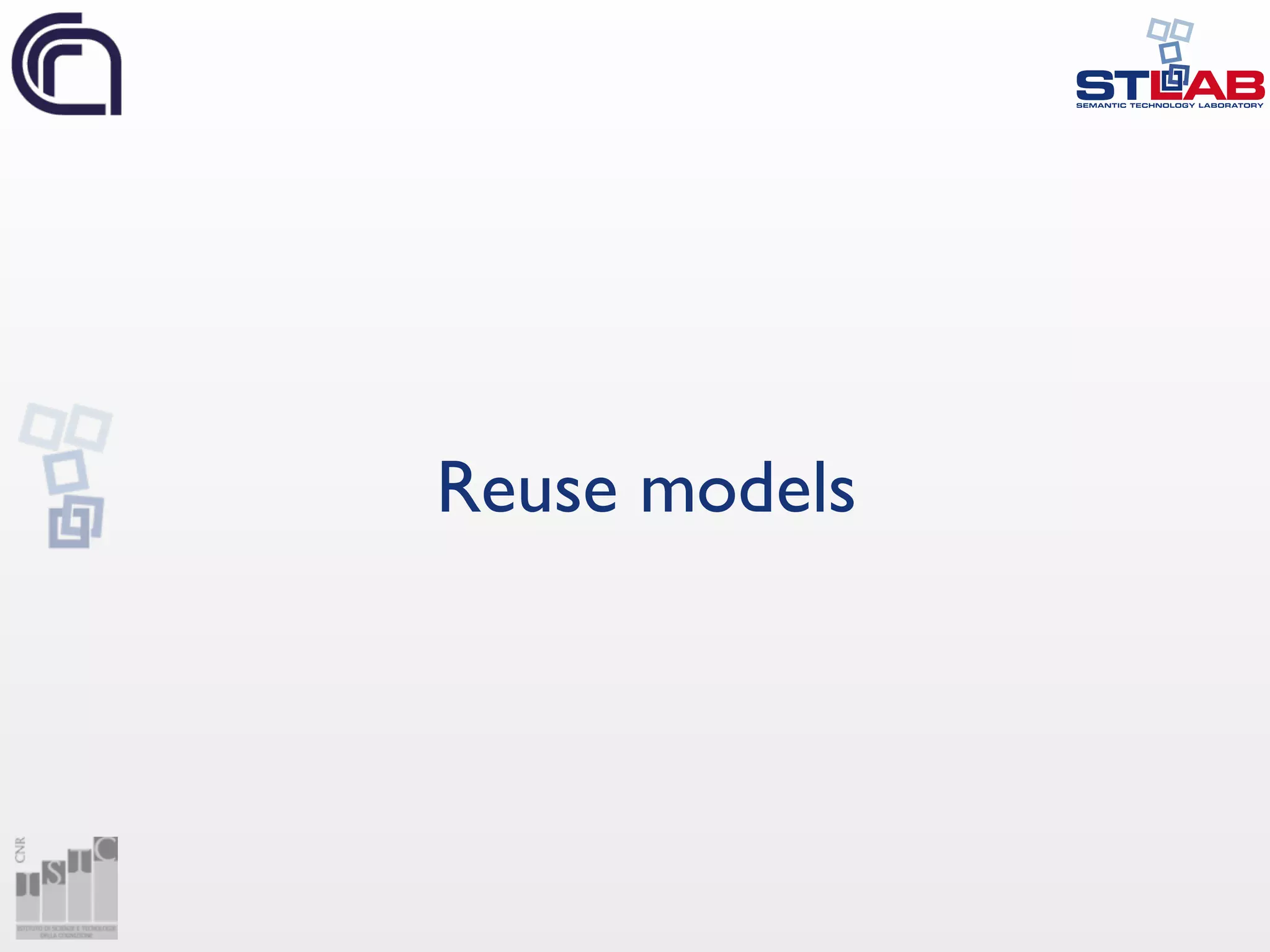
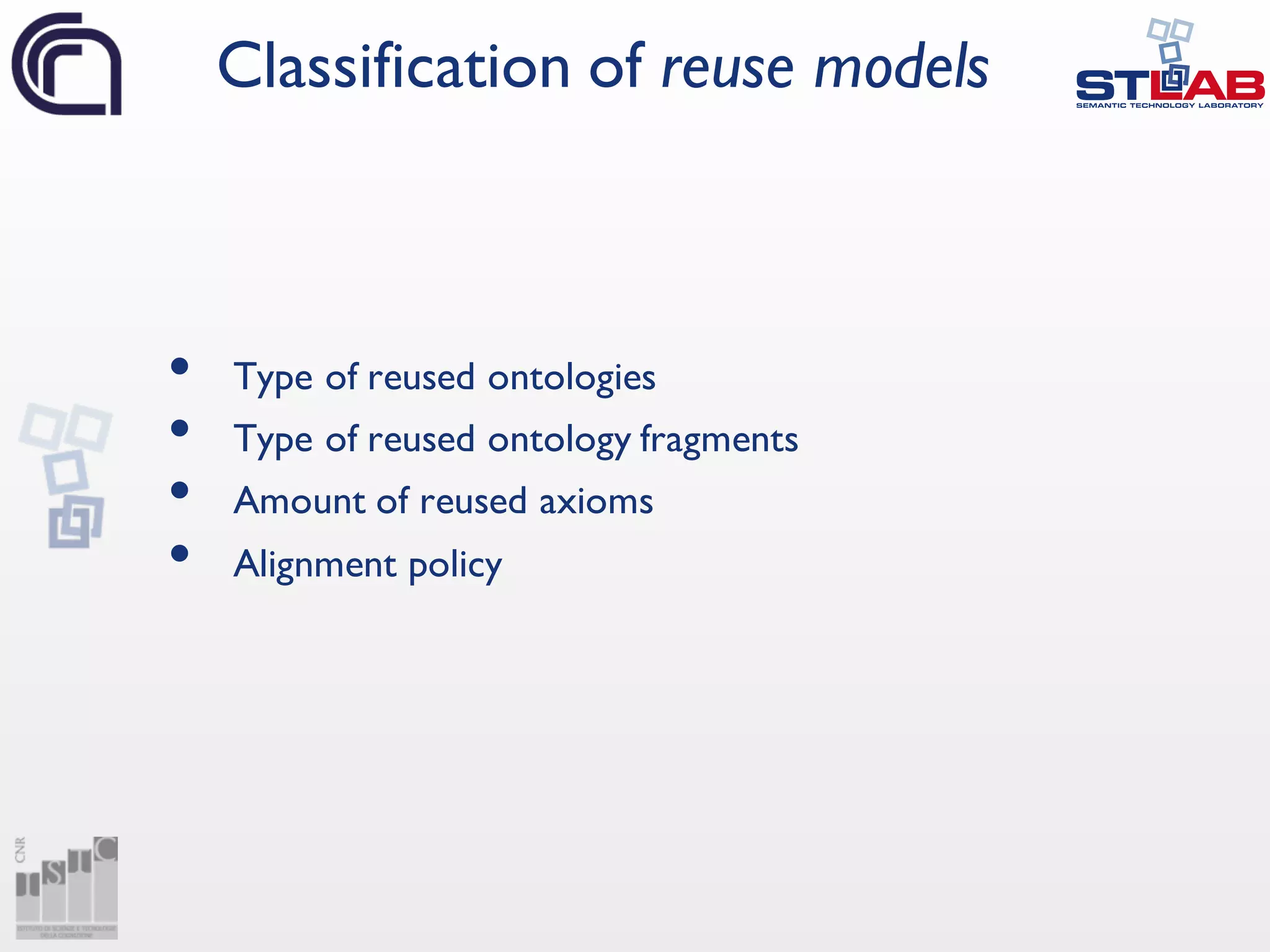
![Reuse of foundational [Gangemi et al, 2003] or top-level
ontologies [DBpedia Ontology]
Specialising DOLCE or the DBpedia Ontology
Modelling events and participation in them
Cultural institutes involved in an exhibition
Type of reused ontologies](https://image.slidesharecdn.com/valentina-161016132631/75/Methods-for-Ontology-Design-Patterns-reuse-9-2048.jpg)
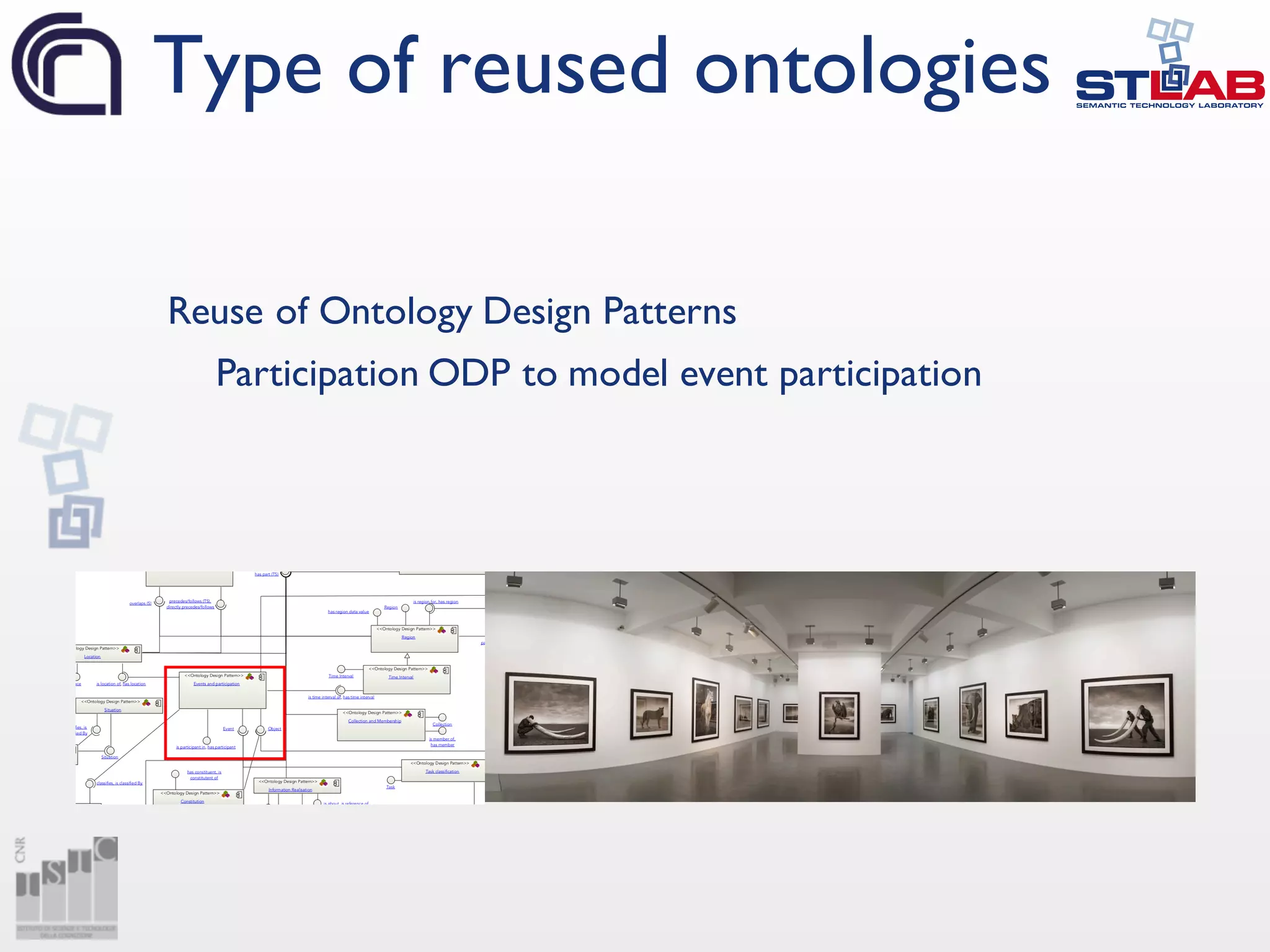
![Reuse of domain ontologies
Reusing the Event Ontology [Raimond and Abdallah, 2007]
Music events
Type of reused ontologies](https://image.slidesharecdn.com/valentina-161016132631/75/Methods-for-Ontology-Design-Patterns-reuse-11-2048.jpg)
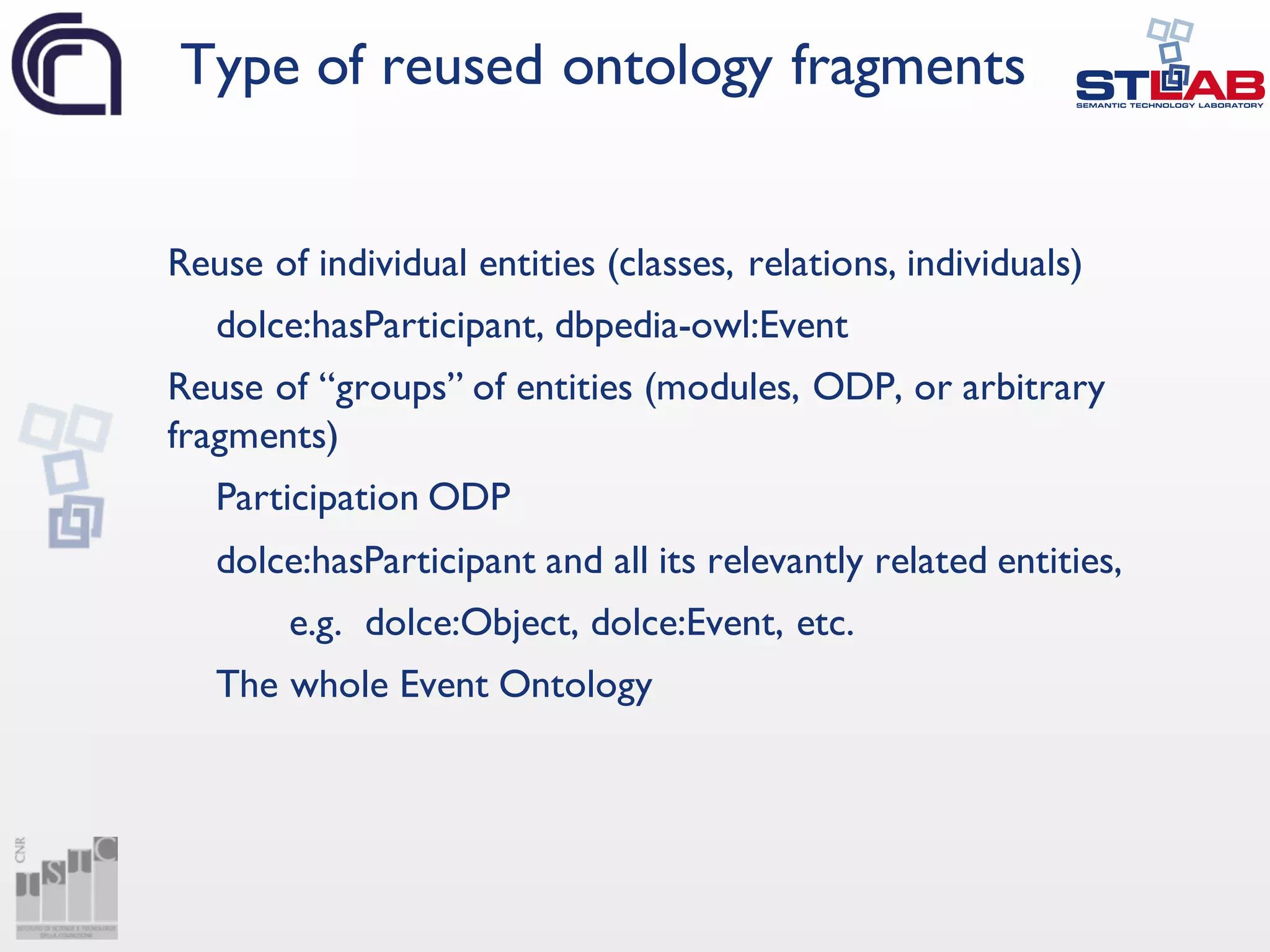
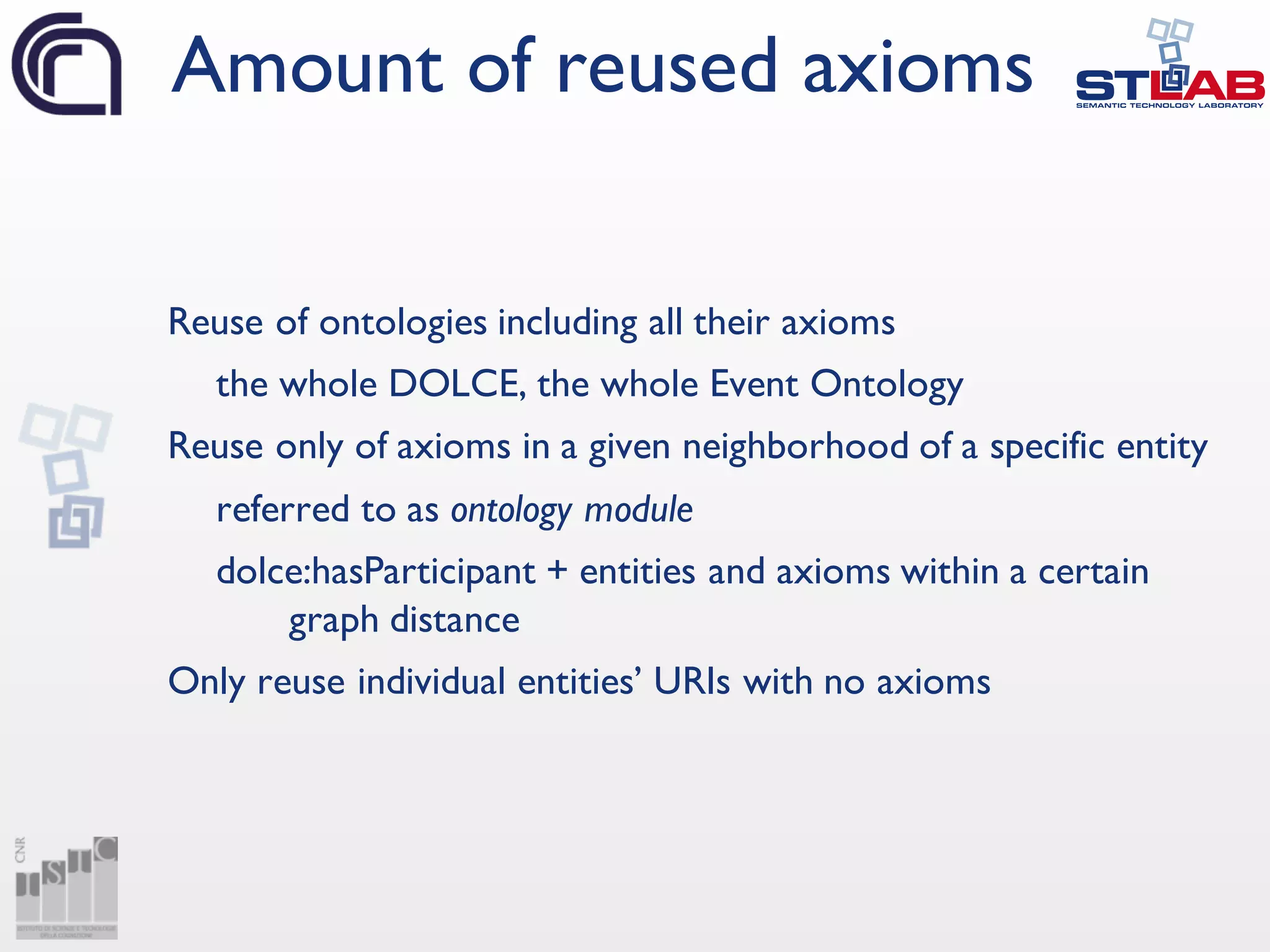
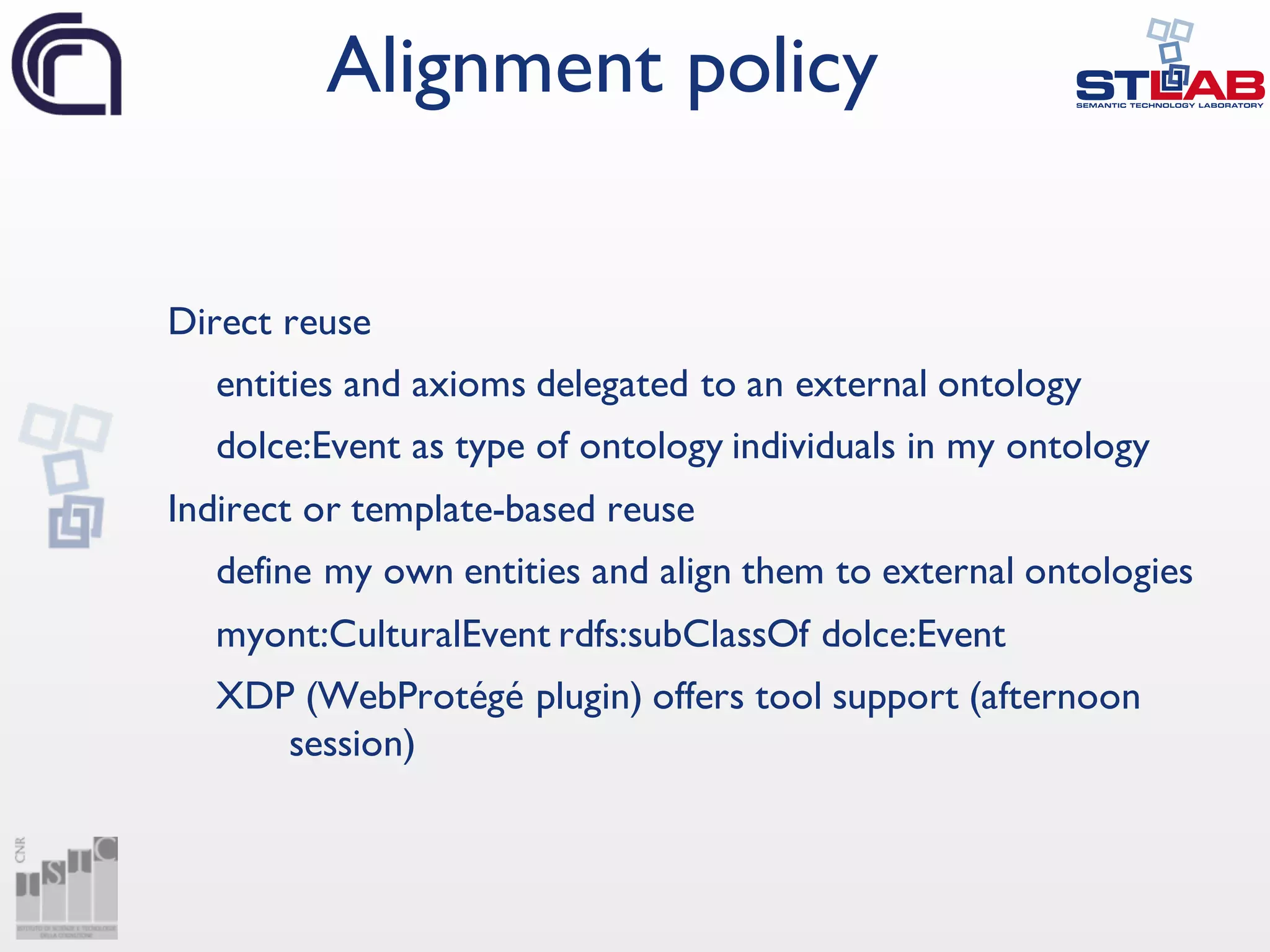
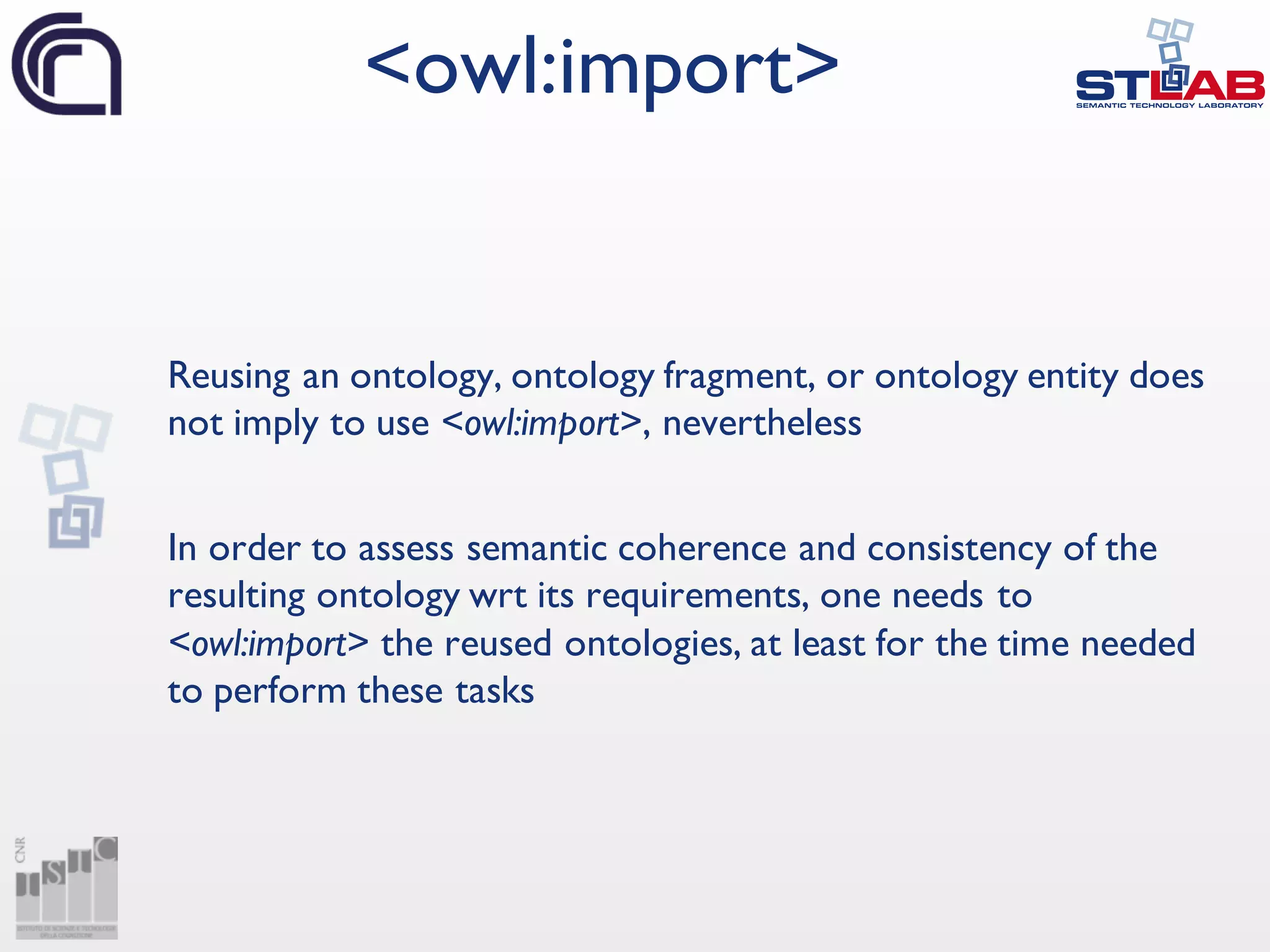

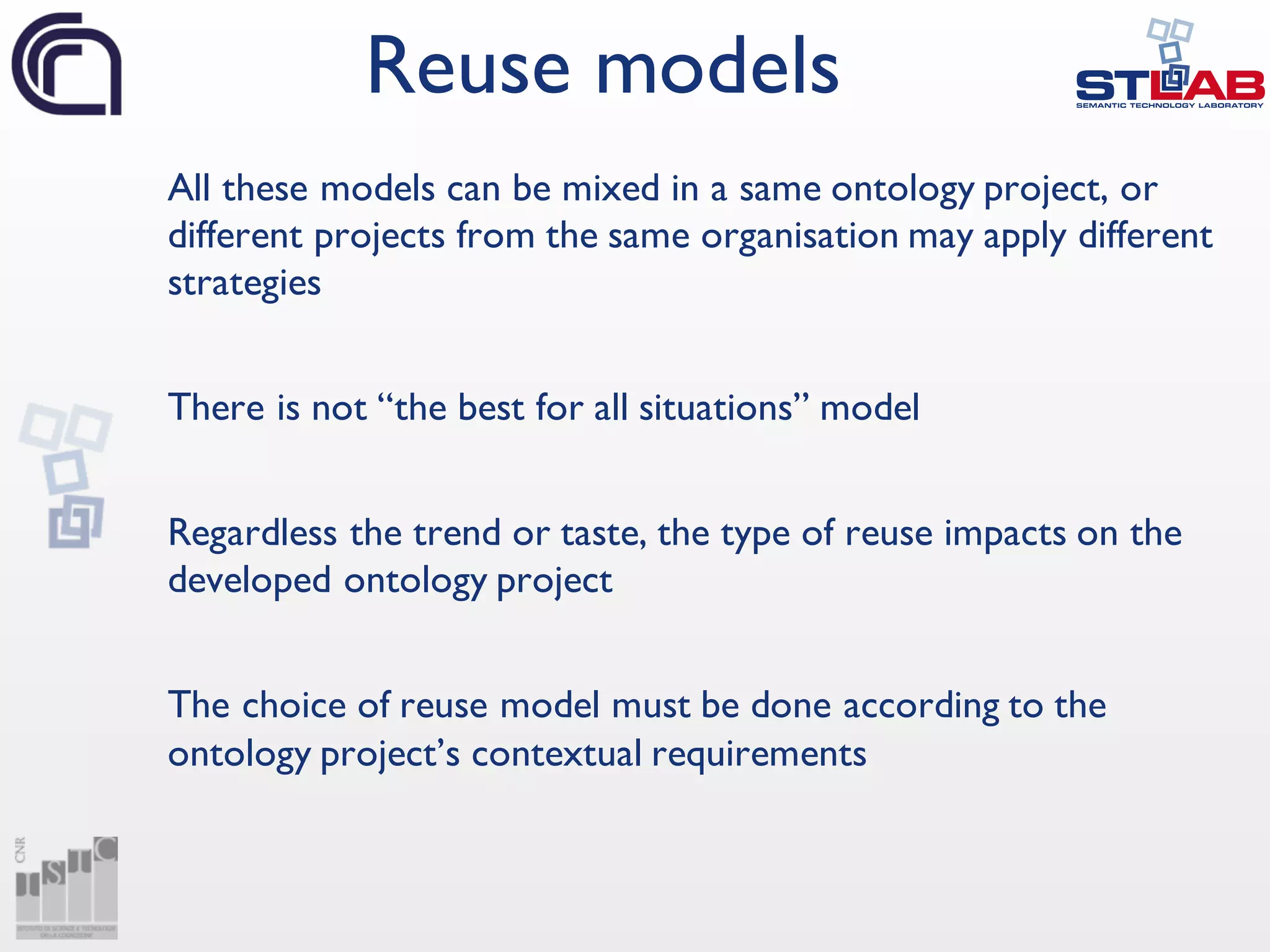
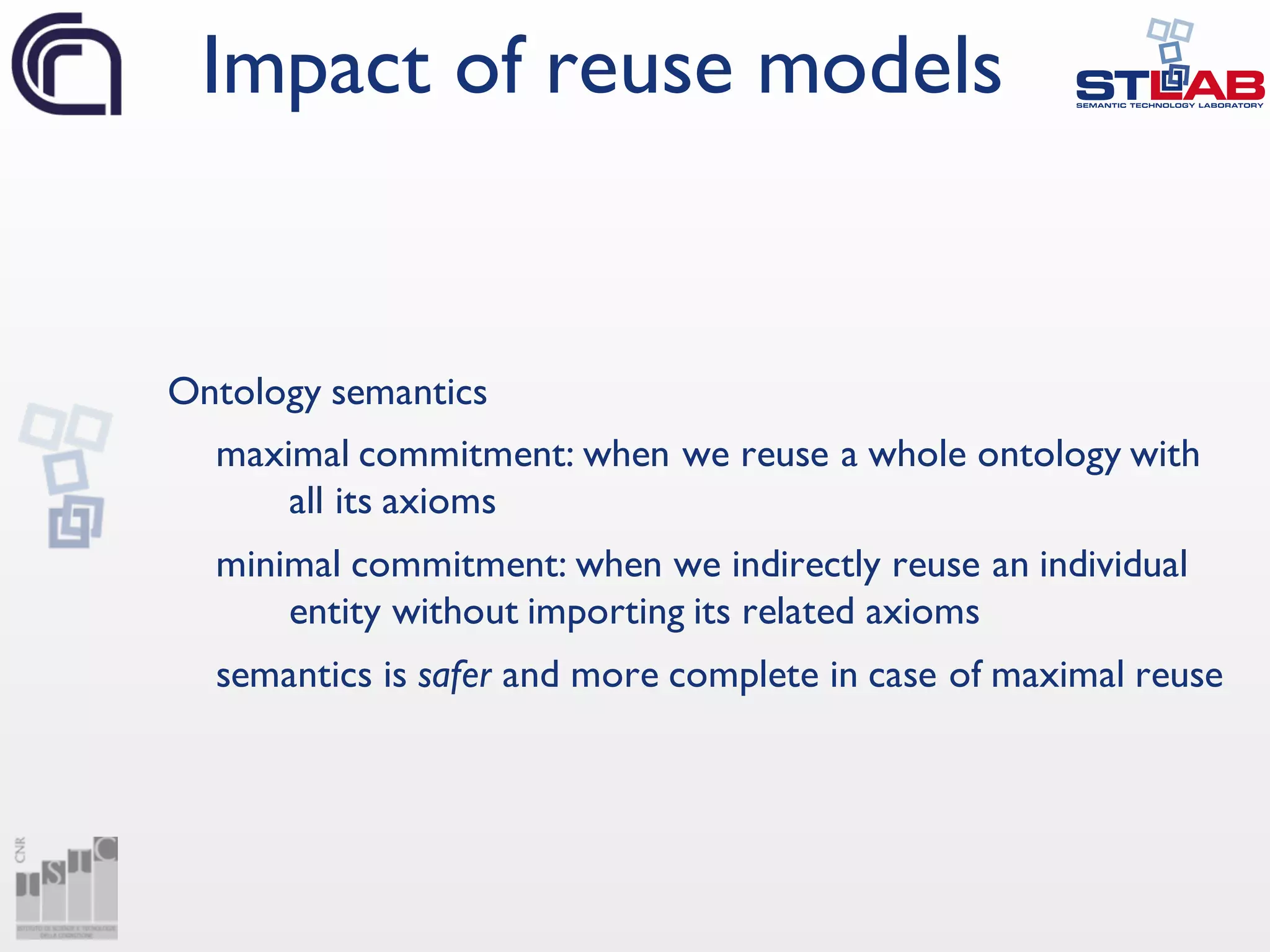
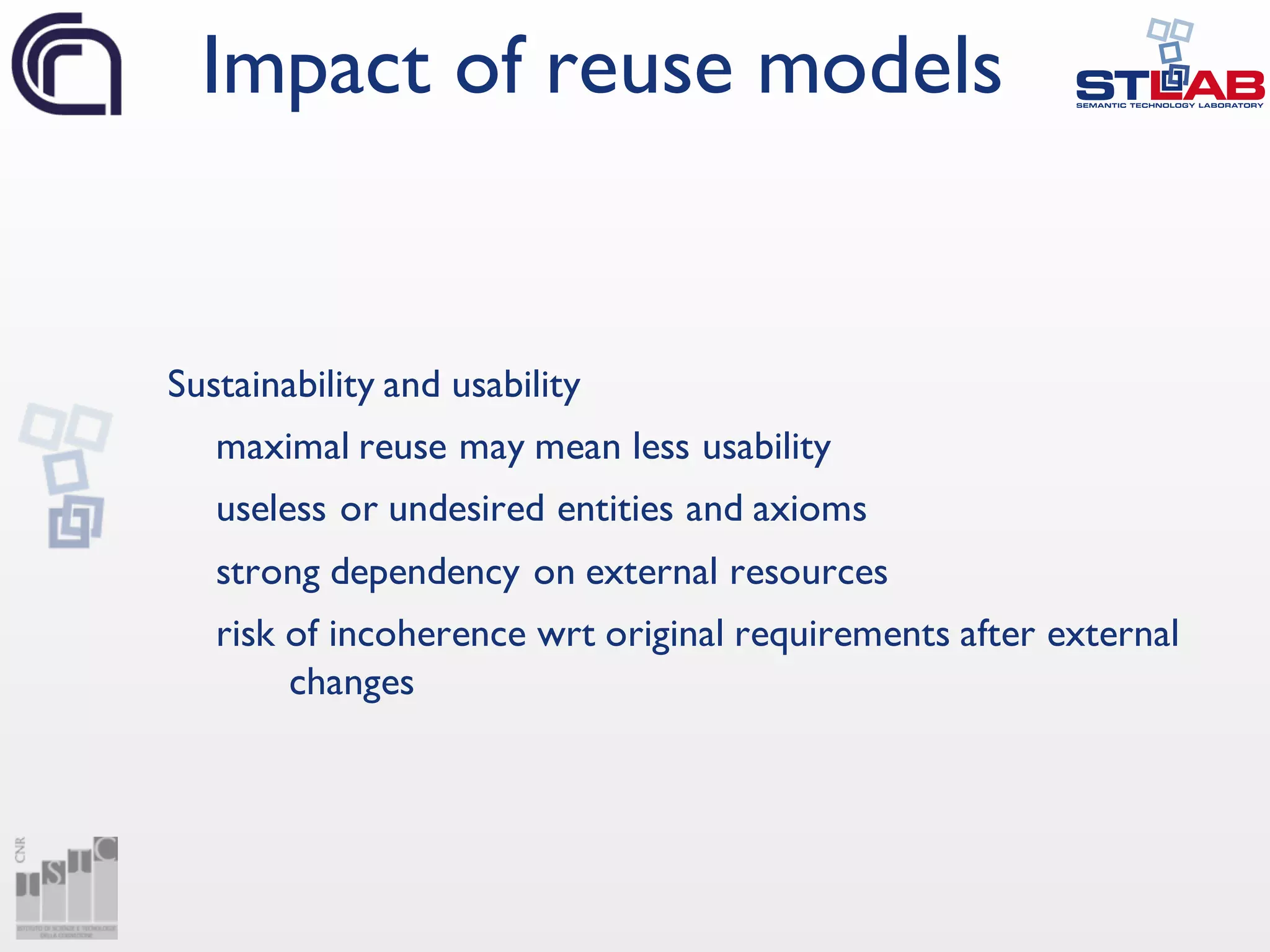
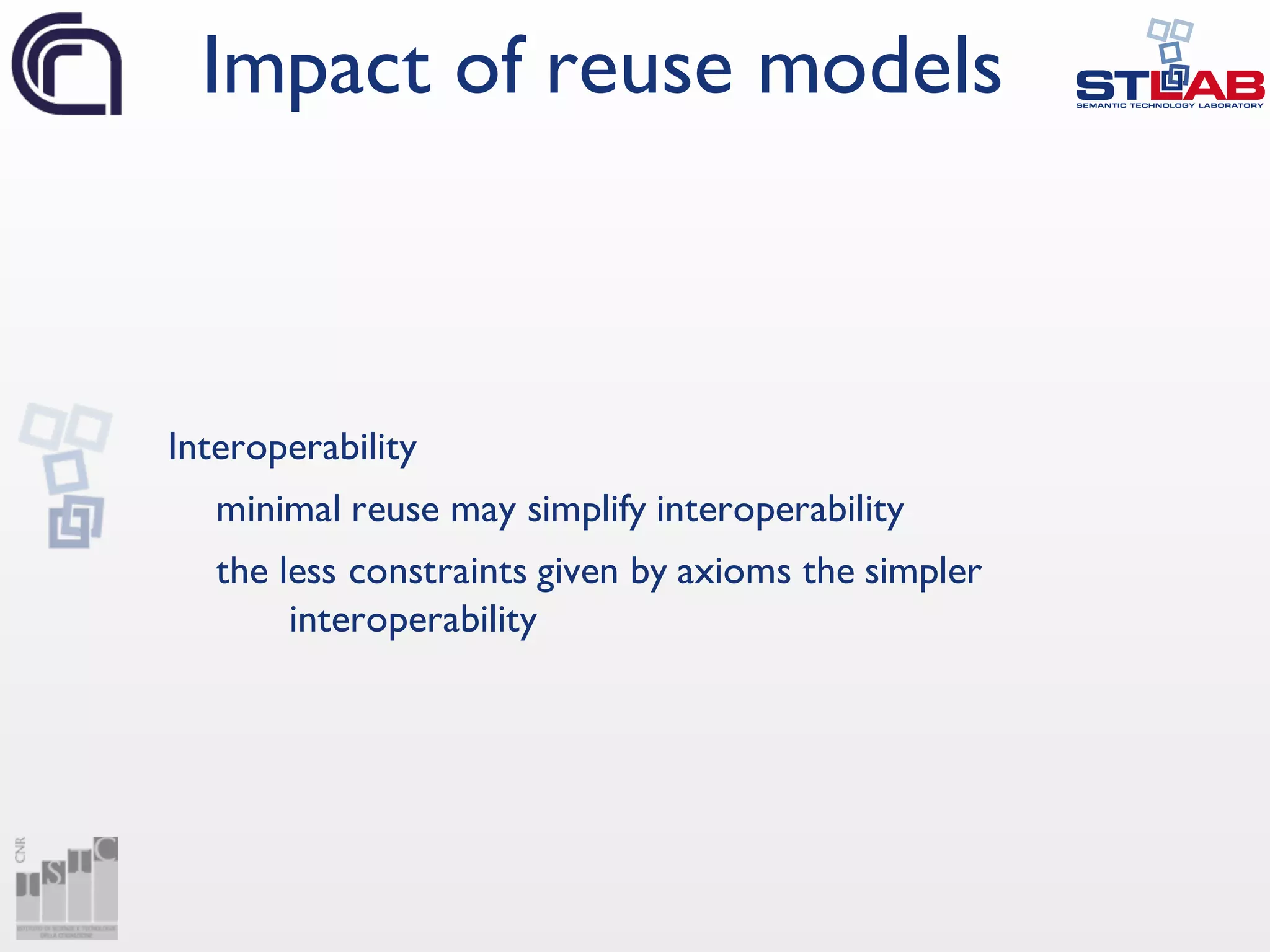

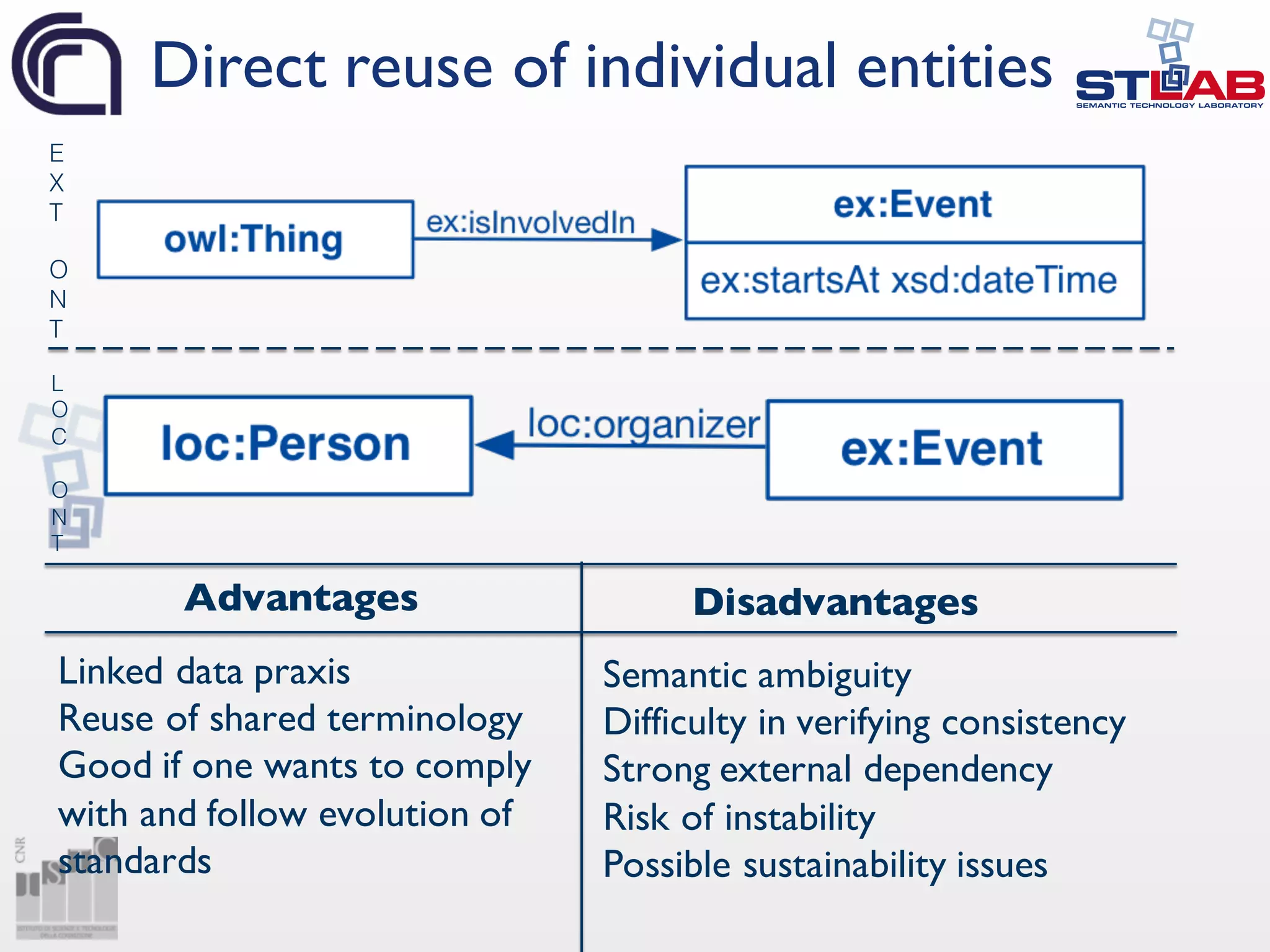
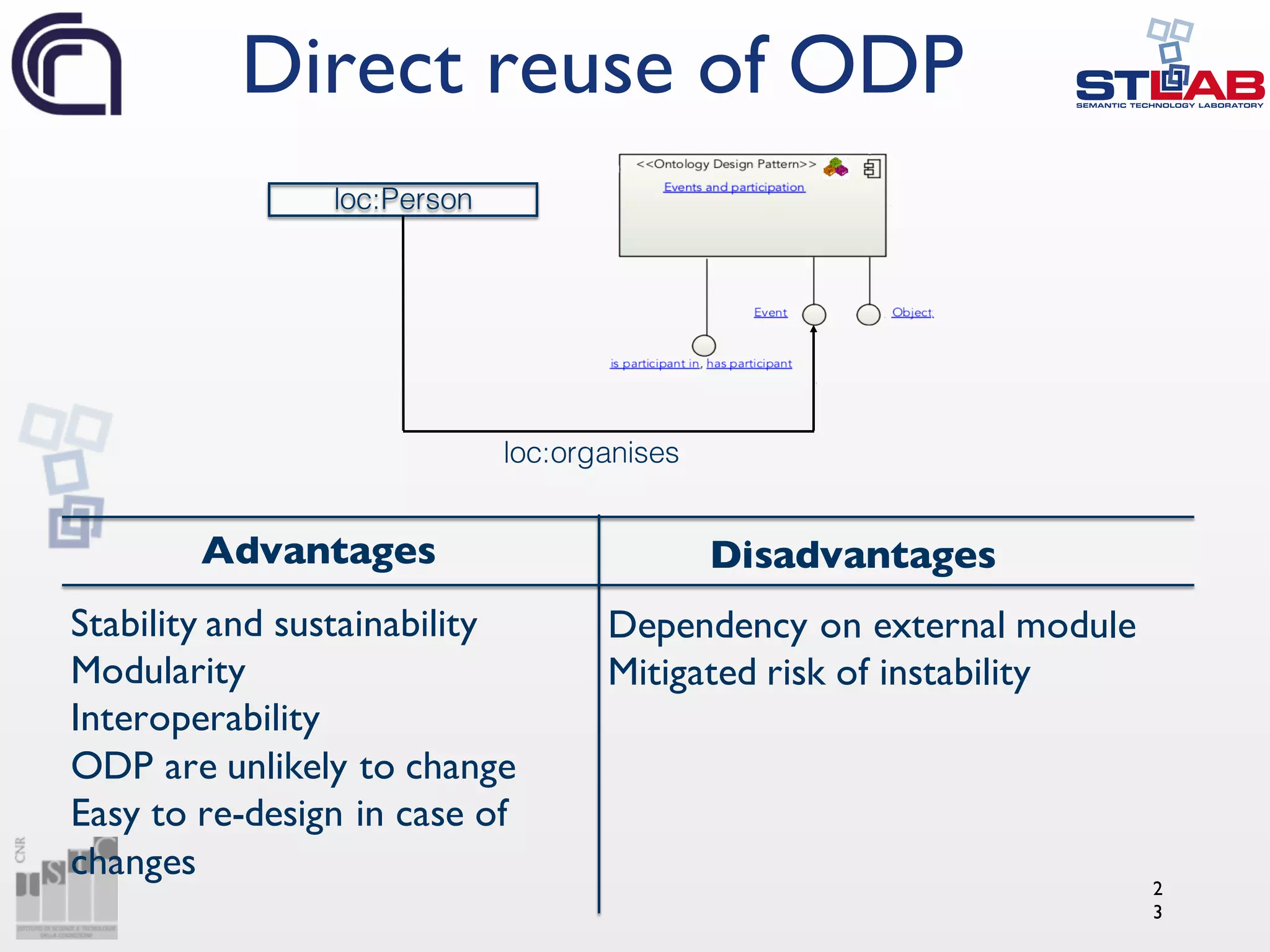
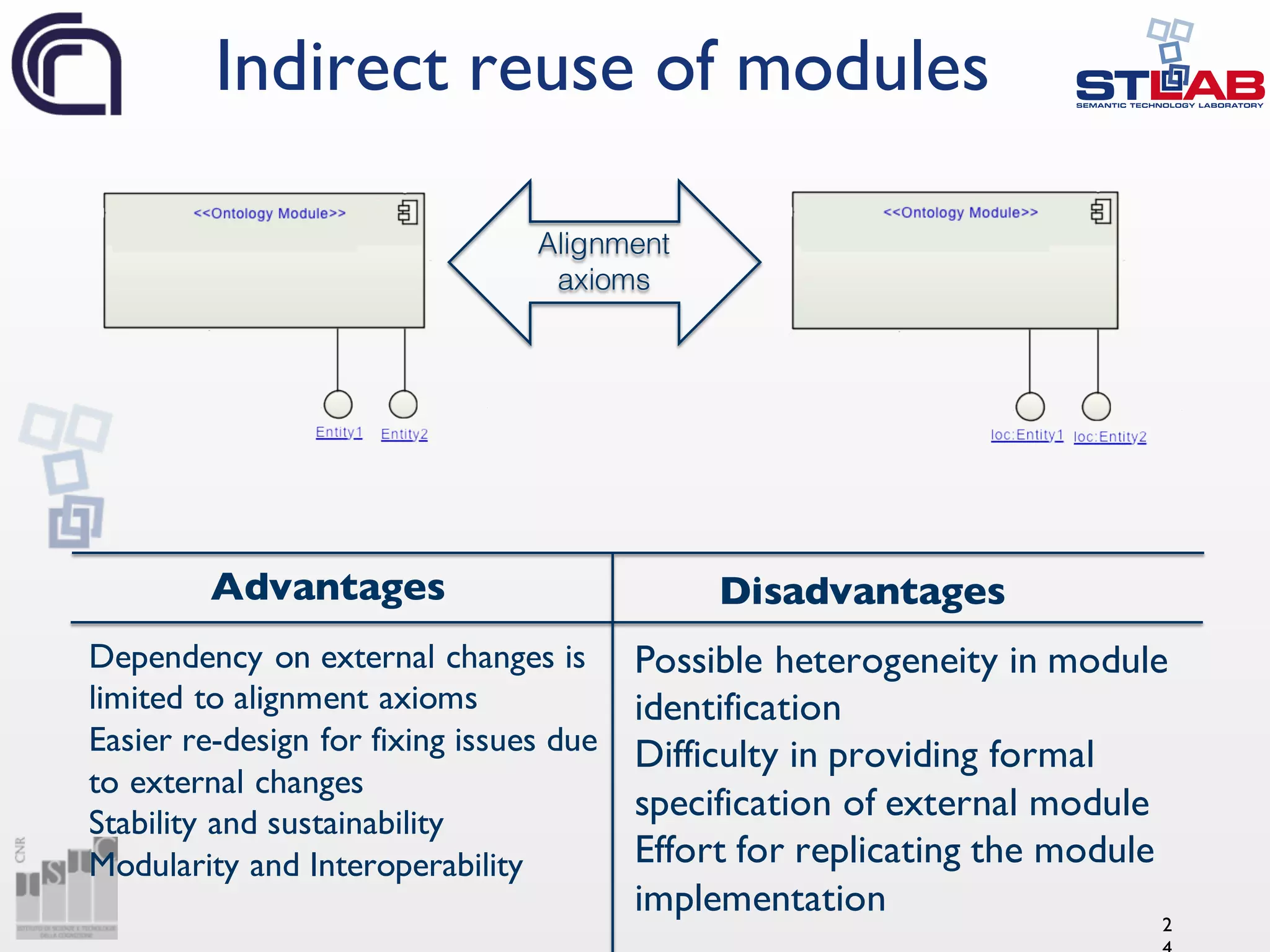

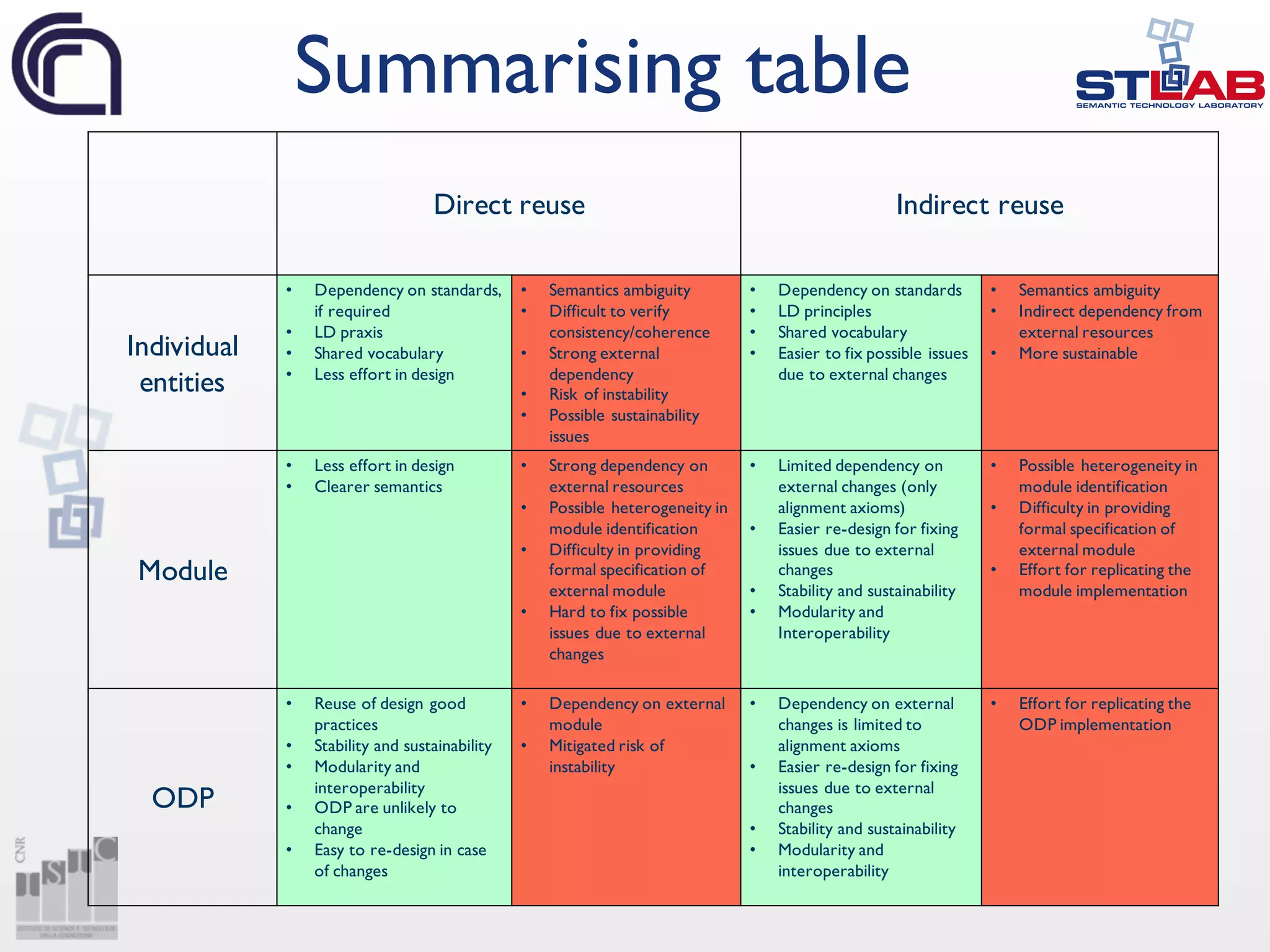
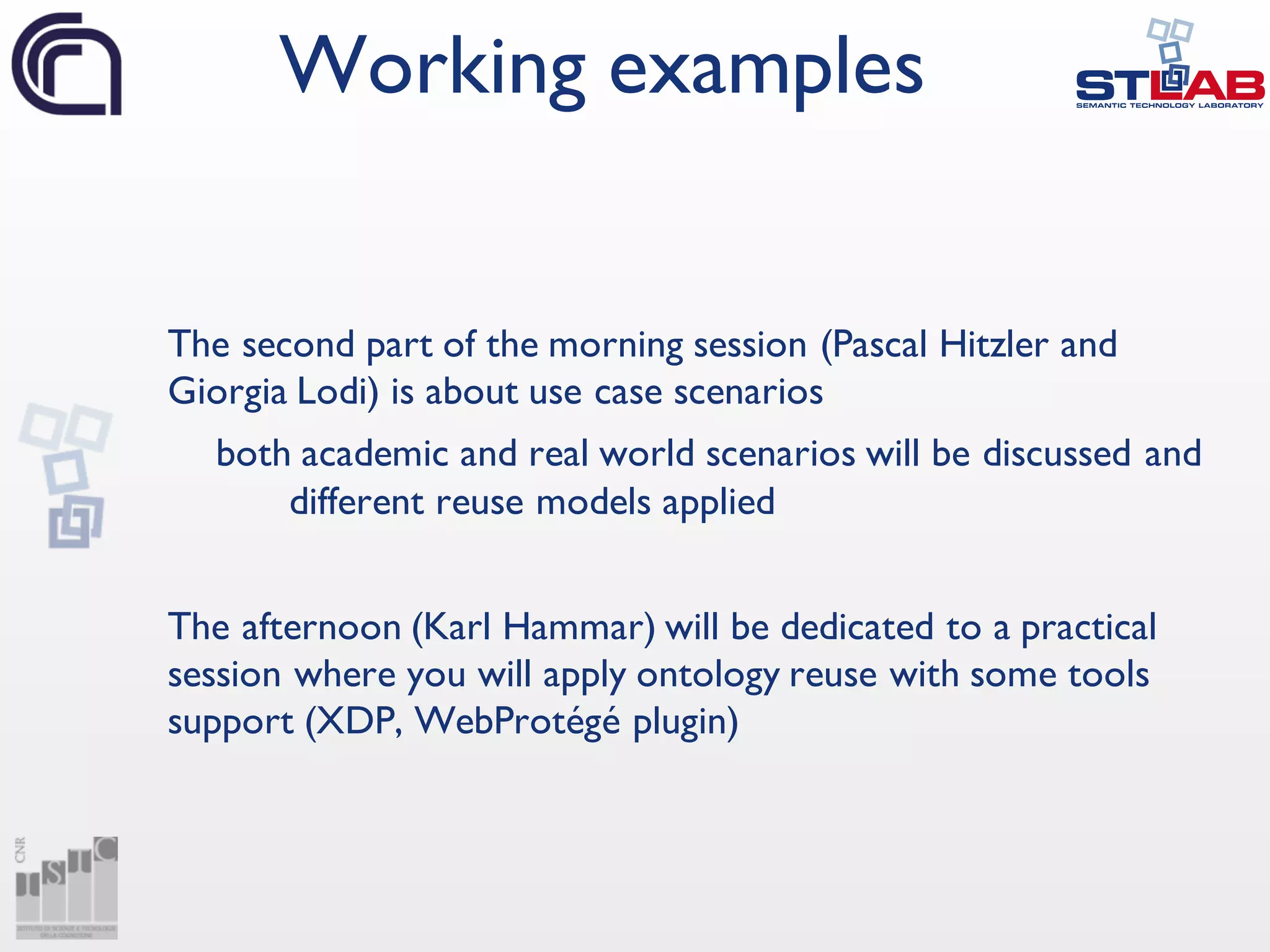
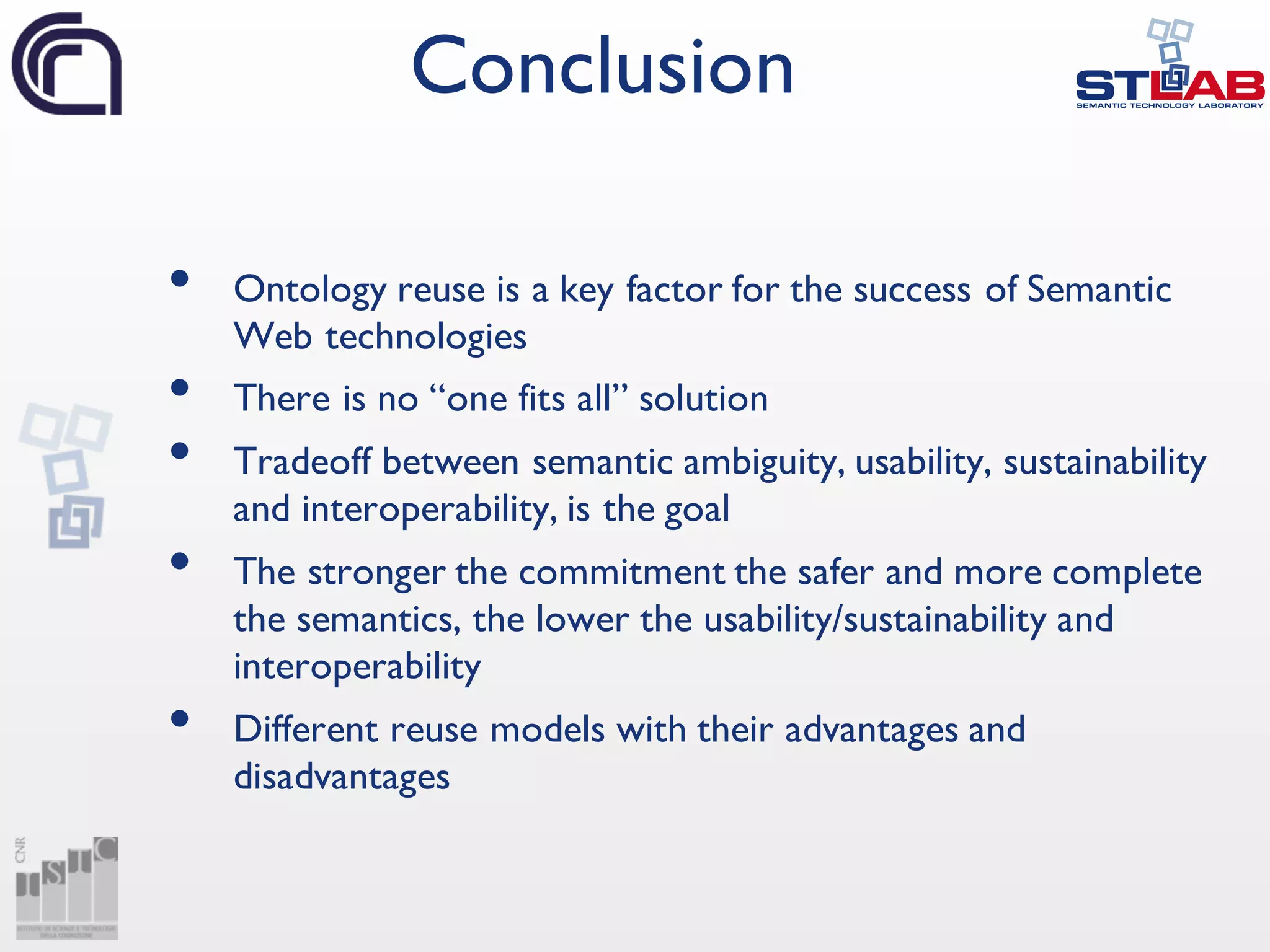
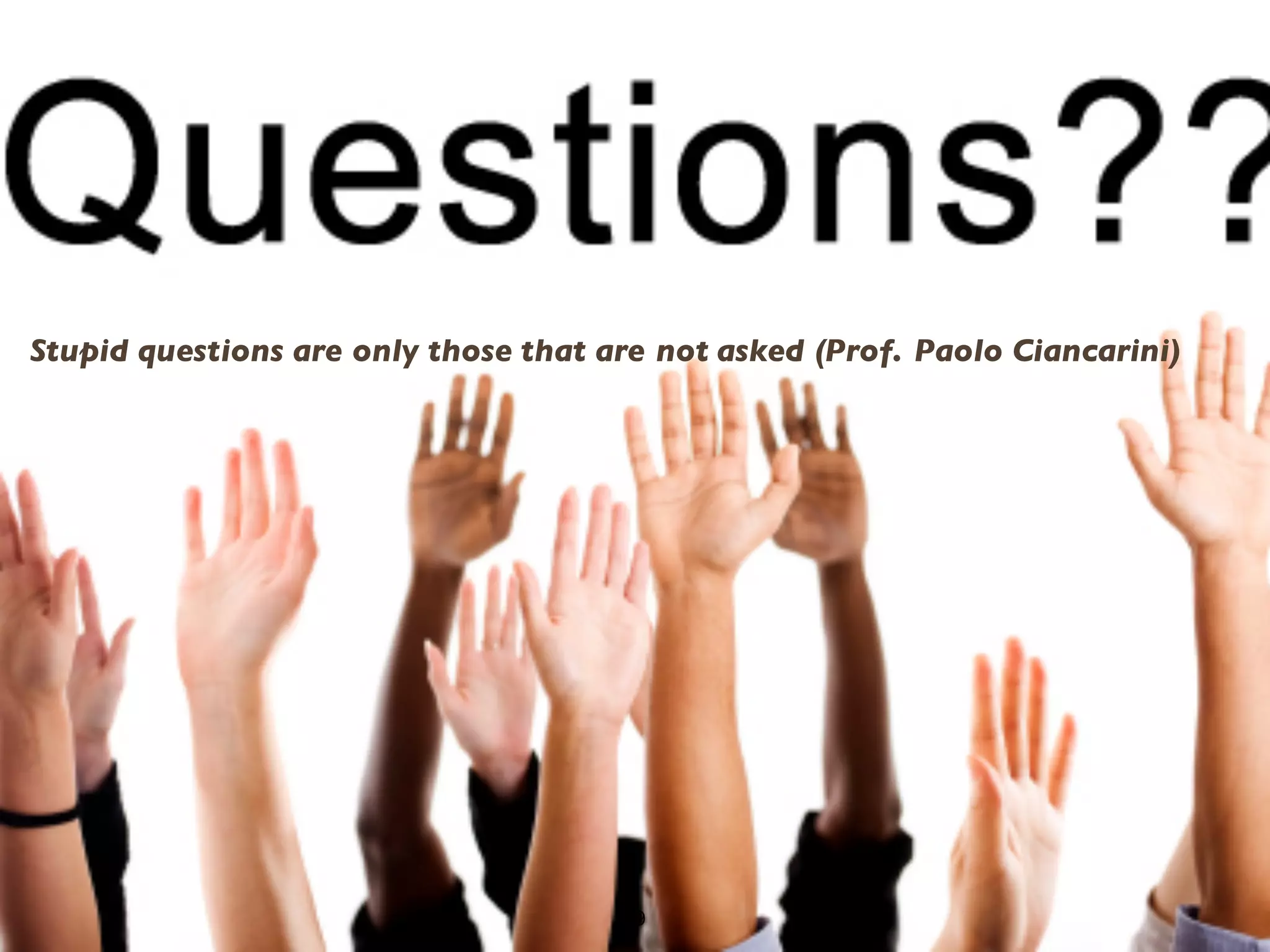
![[Bizer et al., 2009] Christian Bizer, Tom Heath, Tim Berners-Lee:
Linked Data - The Story So Far. Int. J. Semantic Web Inf. Syst. 5(3): 1-22 (2009)
[Burleson et al., 2014] Linked Data Platform Best Practices and Guidelines.
W3C Working Group Note 28 August 2014 https://www.w3.org/TR/ld-bp/
[Simperl, 2009] Elena Paslaru Bontas Simperl: Reusing ontologies on the Semantic Web:
A feasibility study. Data Knowl. Eng. 68(10): 905-925 (2009)
[Gangemi, 2005] Aldo Gangemi: Ontology Design Patterns for Semantic Web
Content. International Semantic Web Conference 2005: 262-276
[Gangemi et al. 2003] Aldo Gangemi, Nicola Guarino, Claudio Masolo, Alessandro
Oltramari: Sweetening WORDNET with DOLCE. AI Magazine 24(3): 13-24 (2003)
[d’Aquin and Noy, 2012]
[DBpedia Ontology] The DBpedia Ontology: http://wiki.dbpedia.org/services-
resources/ontology
[Raimond and Abdallah, 2007] The event ontology. Technical report, 2007.
References](https://image.slidesharecdn.com/valentina-161016132631/75/Methods-for-Ontology-Design-Patterns-reuse-30-2048.jpg)
![[Suárez-Figueroa et al., 2011] Mari Carmen Suárez-Figueroa, Asunción Gómez-
Pérez, Mariano Fernández-López: The NeOn Methodology for Ontology
Engineering. Ontology Engineering in a Networked World 2012: 9-34
[Fernández-López et al, 2011] Mariano Fernández-López, Mari Carmen Suárez-
Figueroa, Asunción Gómez-Pérez: Ontology Development by Reuse. Ontology
Engineering in a Networked World 2012: 147-170
[Schaible et al, 2014] Johann Schaible, Thomas Gottron, Ansgar Scherp: Survey on
Common Strategies of Vocabulary Reuse in Linked Open Data
Modeling. ESWC 2014: 457-472
[Presutti et al, 2016] Valentina Presutti, Giorgia Lodi, Andrea Giovanni Nuzzolese, Aldo
Gangemi, Silvio Peroni and Luigi Asprino: "The role of Ontology Design Patterns in
Linked Data projects”. ER 2016.
[Lodi et al, 2016] Semantics for Cultural Heritage Valorisation. Giorgia Lodi, Valentina
Presutti, Luigi Asprino, Andrea Nuzzolese, Diego Reforgiato, Aldo Gangemi, Annarita
Orsini, Chiara Veninata. Springer, Data Analytics in Digital Humanities, 2016
[Hammar and Presutti, 2016] Karl Hammar and Valentina Presutti - Template-Based
Content ODP Instantiation. In WOP 2016. IOS Press
References](https://image.slidesharecdn.com/valentina-161016132631/75/Methods-for-Ontology-Design-Patterns-reuse-31-2048.jpg)